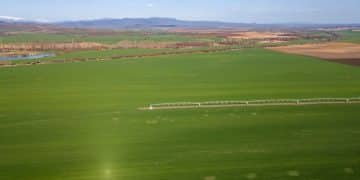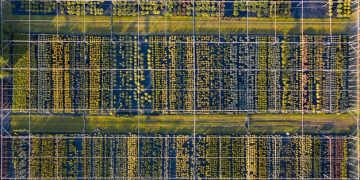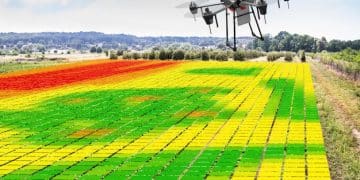Soil Sensors: Optimize Nutrients & Boost Profits in US Farms
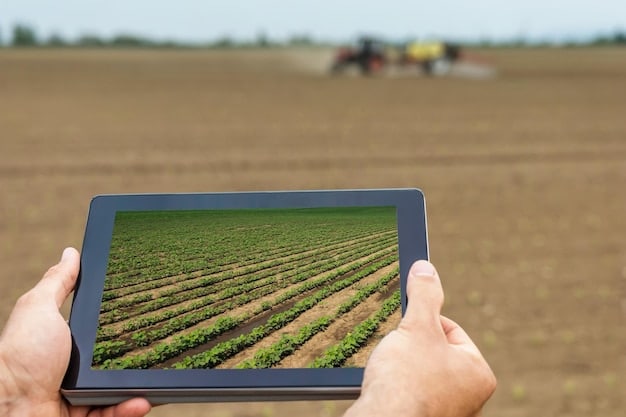
Soil sensors unlock hidden data to optimize nutrient management, increase yields, and maximize profits for farms in the US, providing real-time insights into soil conditions.
Are you a US farmer looking to improve your crop yields and boost your bottom line? The secret might be right beneath your feet: your soil. Soil sensors unlock a wealth of hidden data, enabling you to optimize nutrient management and increase profits like never before.
Understanding the Basics of Soil Sensors
Soil sensors are devices that measure various soil properties, providing valuable data for farmers. This information enables informed decision-making regarding irrigation, fertilization, and overall soil management.
Think of soil sensors as your farm’s silent data collectors, constantly monitoring conditions and providing you with the insights you need to make smart choices. But how do they work, and what exactly do they measure?
How Soil Sensors Work
Soil sensors utilize various technologies to measure soil properties. These technologies include electrical resistance, capacitance, and electromagnetic induction. The specific technology used depends on the type of soil property being measured.
Key Soil Properties Measured by Sensors
Soil sensors can measure a wide range of soil properties, with the most common being moisture content, temperature, and nutrient levels. However, some advanced sensors can also measure pH, salinity, and organic matter content.
- Moisture content: Crucial for irrigation management and preventing water stress in plants.
- Temperature: Affects seed germination, root growth, and nutrient uptake.
- Nutrient levels: Indicates the availability of essential nutrients like nitrogen, phosphorus, and potassium.
- pH: Impacts nutrient availability and microbial activity.
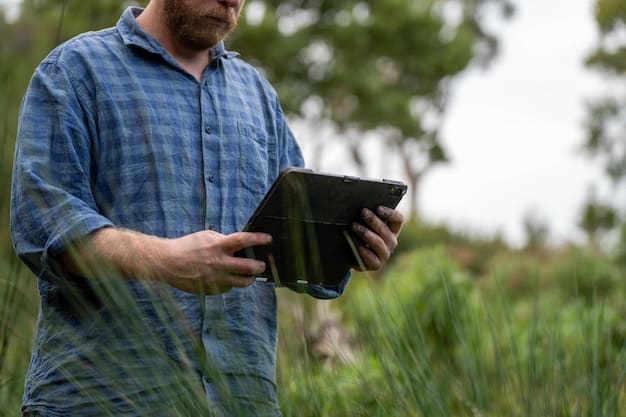
By understanding the basics of soil sensors and the critical properties they measure, farmers can begin to unlock the potential for improved crop yields and resource efficiency.
Benefits of Using Soil Sensors for Nutrient Management
Implementing soil sensors can revolutionize how you manage nutrients on your farm. The advantages span from optimizing fertilizer application to reducing environmental impact.
Imagine knowing exactly when and where your crops need nutrients, rather than relying on guesswork or traditional methods. This precision leads to significant benefits, both for your farm’s productivity and the environment.
Optimizing Fertilizer Application
Soil sensors provide real-time data on nutrient levels, allowing farmers to apply fertilizers precisely when and where they are needed. This targeted approach minimizes waste and ensures that plants receive the optimal amount of nutrients.
Reducing Environmental Impact
By optimizing fertilizer application, soil sensors help to reduce nutrient runoff and leaching, minimizing the risk of water pollution. This contributes to more sustainable farming practices and protects the environment.
- Reduced fertilizer costs: Applying fertilizer only when and where needed saves money.
- Improved water quality: Minimizing runoff protects local waterways.
- Healthier soil: Balanced nutrient levels promote beneficial microbial activity.
The environmental benefits of using soil sensors are becoming increasingly important as consumers demand more sustainable agricultural practices.
The ROI: How Soil Sensors Increase Farm Profits
Investing in soil sensors isn’t just about improving soil health; it’s about boosting your bottom line. The return on investment (ROI) comes from increased yields, reduced input costs, and improved resource efficiency.
Farmers are often concerned about the upfront costs of new technology, but the long-term benefits of soil sensors can far outweigh the initial investment. Let’s explore how these sensors translate into tangible profits.
Increased Crop Yields
By optimizing nutrient management and irrigation, soil sensors help to create ideal growing conditions for crops. This results in increased yields and higher overall productivity.
Reduced Input Costs
Soil sensors minimize waste and optimize resource utilization, leading to significant savings on fertilizer, water, and other inputs. This reduced overhead translates directly into higher profits.
- Data-driven decisions: Replace guesswork with precise data for optimal resource allocation.
- Early problem detection: Identify and address issues before they impact yields.
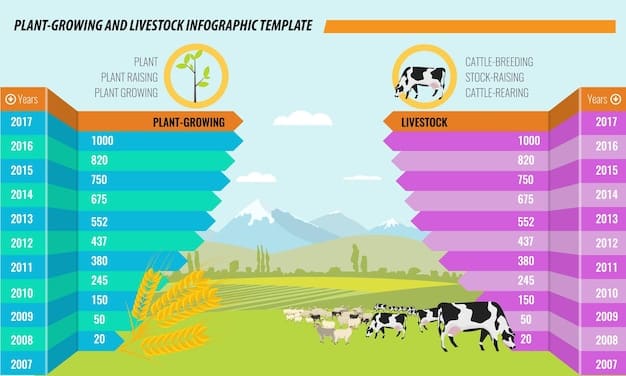
Investing in sensors is investing in the future of your farm. The data-driven insights lead to both immediate cost savings and long-term gains in productivity.
Types of Soil Sensors and Their Applications
The market offers many types of soil sensors, each designed for specific applications and measuring different soil properties. Choosing the right sensor depends on your farming needs and goals.
Not all soil sensors are created equal. Understanding the different types, their capabilities, and their limitations is crucial for making an informed purchasing decision.
Moisture Sensors
These sensors measure the amount of water in the soil, providing valuable data for irrigation management. Different types of moisture sensors include capacitance sensors, TDR sensors, and tensiometers.
Nutrient Sensors
Nutrient sensors measure the levels of essential nutrients in the soil, such as nitrogen, phosphorus, and potassium. These sensors help farmers to optimize fertilizer application and prevent nutrient deficiencies.
Emerging Sensor Technologies
The field of soil sensing technology is constantly evolving, with new and innovative sensors being developed all the time. These include sensors that can measure soil health indicators, such as microbial activity and organic matter content.
- Cost: Balance the features and functionalities with the budget.
- Durability: Ensure sensors are robust enough to withstand field conditions.
Staying informed about the different types of sensors available and their specific applications empowers farmers to select the best technology for their unique needs.
Implementing Soil Sensors on Your Farm
Successfully integrating soil sensors into your farming operation requires careful planning and execution. From sensor placement and data interpretation to integrating the data into your existing farm management system, each step is critical.
Thinking about adopting soil sensors? Here’s a practical guide to get you started, from choosing the right locations for placement to making sense of the data and integrating it into your overall farm strategy.
Choosing the Right Sensor Placement
The placement of soil sensors is critical for obtaining accurate and representative data. Sensors should be placed in areas that are representative of the field as a whole, taking into account factors such as soil type, topography, and crop variability.
Interpreting Data and Making Decisions
Soil sensor data must be interpreted correctly to make informed decisions about nutrient management and irrigation. Farmers should work with agricultural experts to develop data-driven strategies.
- Start with a pilot program: Test the technology on a small scale before full implementation.
- Seek expert advice: Consult with agronomists or soil scientists for optimal results.
By following these steps, farmers can successfully implement sensors and unlock the full potential of the technology.
Challenges and Considerations for Soil Sensor Adoption
Despite the numerous benefits, adopting soil sensors also presents certain challenges. These can include the initial cost of investment, the need for technical expertise, and the management of large data sets.
No technology is without its hurdles. Being aware of the challenges and potential pitfalls of using soil sensors will help you overcome them and ensure a successful implementation.
Initial Investment Costs
The upfront cost of purchasing and installing can be a significant barrier for some farmers. However, government incentives and financing options can help to offset these costs.
Need for Technical Expertise
Soil sensors require some level of technical expertise to install, maintain, and interpret the data. Farmers should invest in training or seek support from agricultural experts.
By addressing these challenges proactively, farmers can overcome the barriers to adoption and reap the rewards of data-driven farming.
| Key Point | Brief Description |
|---|---|
| 🌱 Nutrient Optimization | Precise monitoring ensures efficient fertilizer use, increasing crop health. |
| 💧 Water Management | Real-time moisture data helps prevent over or under-watering, conserving resources. |
| 💰 Profit Boost | Higher yields and reduced inputs lead to greater profitability. |
| 📊 Data-Driven Decisions | Make informed choices based on accurate soil insights, not guesswork. |
Frequently Asked Questions (FAQ)
▼
Soil sensors provide real-time moisture data, allowing farmers to irrigate only when and where needed. This prevents overwatering and under-watering, improving water use efficiency.
▼
Yes, they provide precise data on nutrient levels, enabling farmers to apply fertilizers only to areas where they are needed, reducing overall fertilizer consumption and costs.
▼
Most crops can benefit, but those sensitive to water and nutrient imbalances, such as high-value fruits and vegetables, often see the greatest improvements in yield and quality.
▼
Calibration frequency depends on the sensor type and manufacturer recommendations. Generally, calibrating annually or semi-annually ensures accurate readings and reliable data.
▼
Yes, the USDA and other agencies offer various programs and incentives to encourage the adoption of precision agriculture technologies, including soil sensors, to promote sustainable farming practices.
Conclusion
Soil sensors represent a powerful tool for US farmers seeking to optimize nutrient management, increase profits, and promote sustainable farming practices. By unlocking the hidden data within your soil, you can make informed decisions that lead to healthier crops, reduced input costs, and a more resilient farm operation.
